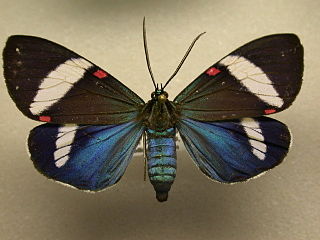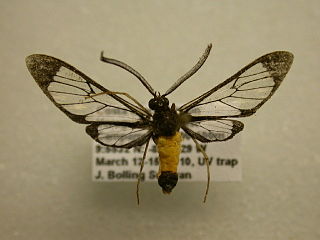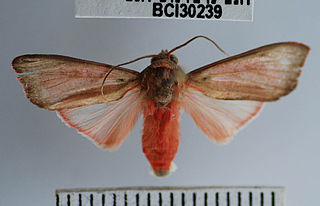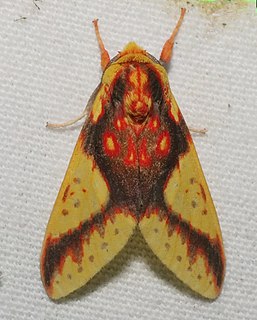
No. 360 Squadron RAF was an electronic countermeasures (ECM) squadron of the Royal Air Force.

Correbia is a genus of moths in the subfamily Arctiinae. The genus was erected by Gottlieb August Wilhelm Herrich-Schäffer in 1855.

Cyanopepla is a genus of moths in the subfamily Arctiinae. The genus was erected by James Brackenridge Clemens in 1861.

Eucereon is a genus of tiger moths in the family Erebidae. The genus was erected by Jacob Hübner in 1819.

Halysidota is a genus of moths in the family Erebidae. The genus was erected by Jacob Hübner in 1819.
Holophaea is a genus of moths in the subfamily Arctiinae. The genus was erected by George Hampson in 1898.

Hypocrita is a genus of tiger moths in the family Erebidae. The genus was erected by Jacob Hübner in 1807.

Idalus is a genus of moths in the family Erebidae. The genus was erected by Francis Walker in 1855.

Isanthrene is a genus of moths in the subfamily Arctiinae. The genus was erected by Jacob Hübner in 1819.

Loxophlebia is a genus of moths in the subfamily Arctiinae. The genus was erected by Arthur Gardiner Butler in 1876.

Melese is a genus of moths in the family Erebidae. The genus was erected by Francis Walker in 1854.

Mesothen is a genus of moths in the subfamily Arctiinae. The genus was erected by George Hampson in 1898.

Pseudophaloe is a genus of tiger moths in the family Erebidae. The genus was described by Hering in 1925.
Melese amastris is a moth of the family Erebidae. It was described by Herbert Druce in 1884. It is found in Mexico, Guatemala, Honduras, Costa Rica and Brazil.

Melese asana is a moth of the family Erebidae. It was described by Herbert Druce in 1884. It is found in Mexico, Panama, Honduras, Colombia and the Amazon region.
Melese chozeba is a moth of the family Erebidae. It was described by Herbert Druce in 1884. It is found in Costa Rica and possibly Colombia.

Melese incertus is a moth of the family Erebidae. It was described by Francis Walker in 1855. It is found in French Guiana, Suriname, Guyana, Brazil, Venezuela, Trinidad, Peru, Bolivia and Panama.
Melese russatus is a moth of the family Erebidae. It was described by Henry Edwards in 1884. It is found in Mexico.
Saurita myrrha is a moth in the subfamily Arctiinae. It was described by Herbert Druce in 1884. It is found in Guatemala.

Symphlebia ipsea is a moth in the family Erebidae. It was described by Herbert Druce in 1884. It is found in Panama.














